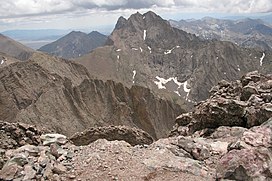Crestone Peak
| Crestone Peak | |
|---|---|
 Crestone Peak seen from Kit Carson | |
| Highest point | |
| Elevation | 14,300 ft (4359 m)[1] NAVD88 |
| Prominence | 4554 ft (1388 m)[1] |
| Isolation | 27.4 mi (44.0 km)[1] |
| Listing | |
| Geography | |
| Location | High point of Saguache County, Colorado, United States.[1] |
| Parent range | Sangre de Cristo Range, Highest summit of the Crestones[1] |
| Topo map(s) | USGS 7.5' topographic map Crestone Peak, Colorado[2] |
| Climbing | |
| First ascent | 1916 by Eleanor Davis and party |
| Easiest route | Scramble (class 3) |
| Crestone East Peak | |
|---|---|
 | |
| Highest point | |
| Elevation | 14,266 ft (4,348 m)[3][4] |
| Prominence | 80 ft (24 m)[4] |
| Parent peak | Crestone Peak[4] |
| Isolation | 0.08 mi (0.13 km)[4] |
| Listing | Colorado county high points |
| Coordinates | 37°58′02″N 105°35′03″W / 37.96729°N 105.58404°W[4] |
| Geography | |
| Location | Saguache County and high point of Custer County, Colorado, U.S.[4] |
Crestone Peak is the seventh-highest summit of the Rocky Mountains of North America and the U.S. state of Colorado. The prominent 14,300-foot (4,359 m) fourteener is the highest summit of the Crestones and the second-highest summit in the Sangre de Cristo Range after Blanca Peak. The summit is located in the Sangre de Cristo Wilderness of Rio Grande National Forest, 5.0 miles (8.1 km) east by south (bearing 102°) of the Town of Crestone in Saguache County, Colorado, United States.[1][2][5]
Crestone Peak rises 7,000 feet (2,100 m) above the east side of the San Luis Valley. It shares its name with the nearby Crestone Needle, another fourteener of the Crestones. The Crestones are a cluster of high summits in the Sangre de Cristo Range, comprising Crestone Peak, Crestone Needle, Kit Carson Peak, Challenger Point, Humboldt Peak, and Columbia Point. They are usually accessed from common trailheads.
Climbing
Generally climbs of Crestone Peak or Crestone Needle start from a base camp at South Colony Lakes, east of the peak, accessed from the Wet Mountain Valley on the northeast side of the range. This route involves nearly 6,000 ft (1,800 m) of elevation gain, and ascends to a large relatively flat area called "The Pool Table" (a few large rocks lie on the tundra, as if billiard balls) or the "Bears' Playground." Then it ascends a long gully on the northwest side of Crestone Peak, which involves some rockfall danger (hence a climbing helmet is suggested). Crestone Peak is one of the more dangerous fourteener climbs in Colorado; accidents occur often in the Crestones, some caused by falls or lightning (a daily summer occurrence in the Sangre de Cristos).
Alternatively, the Cottonwood Creek route begins in the San Luis Valley and approaches the Crestones from the west. The route follows Cottonwood Creek to Cottonwood Lake. From there, the South Face route of Crestone Peak is accessible.
From Crestone Peak, it is a mildly technical (Class 4—rope recommended) ridge scramble to the summit of Crestone Needle, similarly in the other direction. However, Crestone Peak and Crestone Needle are more commonly climbed separately.

See also
References
- ^ a b c d e f "Crestone Peak, Colorado". Peakbagger.com. Retrieved January 2, 2016.
- ^ a b c "Crestone Peak". Geographic Names Information System. United States Geological Survey, United States Department of the Interior. Retrieved November 14, 2014.
- ^ The elevation of Crestone East Peak includes an adjustment of +1.762 metres (5.78 ft) from NGVD 29 to NAVD 88.
- ^ a b c d e f "Crestone Peak-East Peak, Colorado". Peakbagger.com. Retrieved November 14, 2014.
- ^ The elevation of Crestone Peak includes an adjustment of +1.760 m (5.77 ft) from NGVD 29 to NAVD 88.

